Apple Studio Display vs Pro XDR Display: What should you buy?
A round-by-round breakdown of what sets Apple's latest display apart from its most expensive
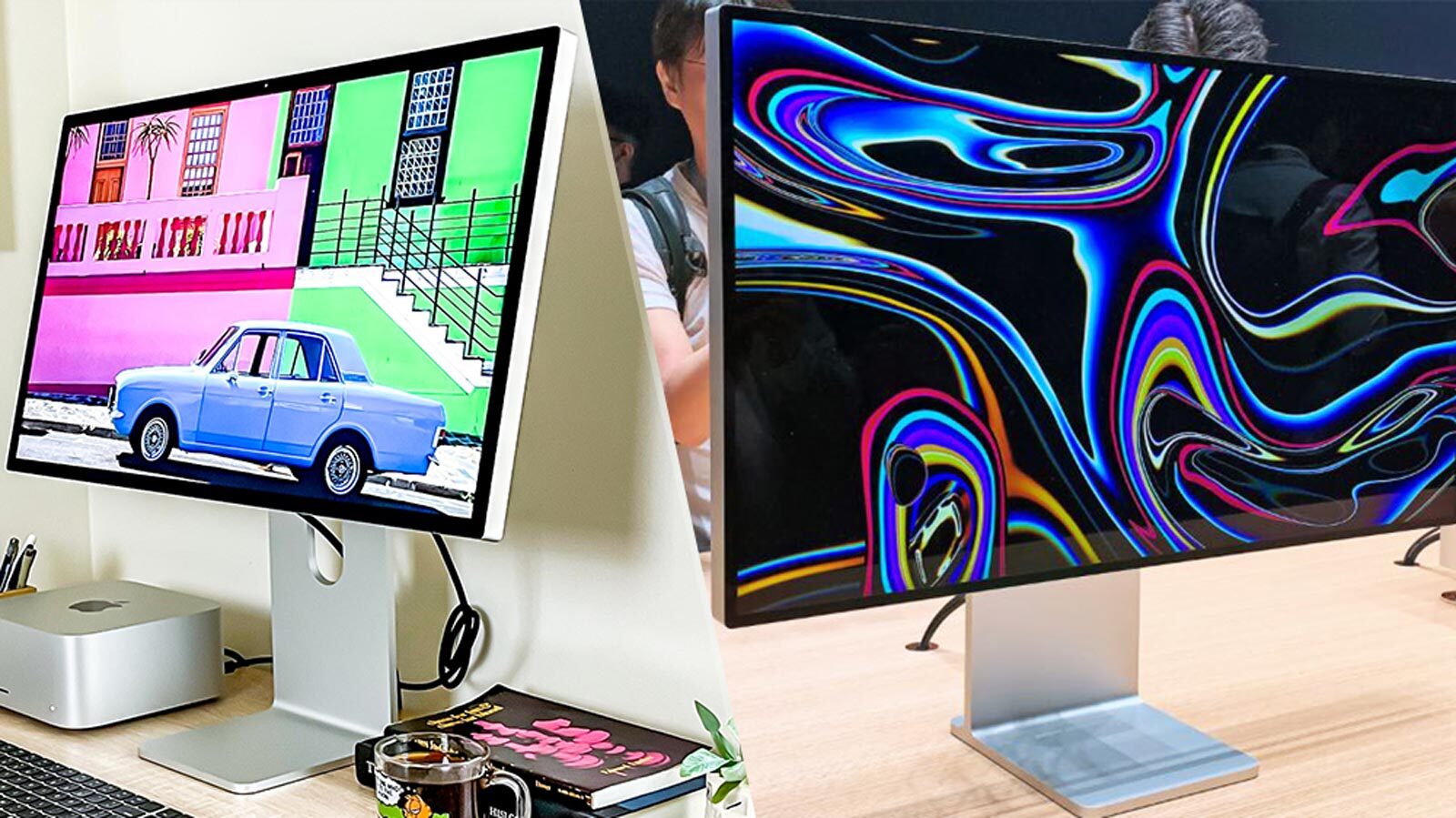
The Apple Studio Display ($1,599) is now on sale, and it's arguably the best monitor for MacBook Pro owners seeking a secondary display. Apple is also marketing it to professionals and creatives who do a lot of photo/video editing, and the Display ships with a slew of reference modes for working with various media formats.
Apple ships its MacBook Pros and Pro Display XDR 6K monitor with similar reference modes, as they're all aimed at the same type of creative pros (and aspiring pros) who prize color accuracy and speedy performance in apps like Adobe Premiere and Photoshop. Which begs the question: What makes the new Studio Display different from Apple's $4,999 Pro Display XDR? (And that's before we even talk about the rumored Apple Studio Display Pro, a rumored middle option between the Studio Display and Pro Display XDR that could arrive later this year.)
To start off our Apple Studio Display vs Pro XDR Display comparison, the 27-inch Studio Display is cheaper and smaller than the Pro Display XDR. It also has a different set of features than the Pro Display XDR, and it's important you know the differences when choosing which monitor is right for you.
Read on for a blow-by-blow breakdown of how these two Apple displays stack up.
Apple Studio Display vs Pro Display XDR: Specs
| Row 0 - Cell 0 | Studio Display | Pro Display XDR |
| Starting Price | $1,599 | $4,999 |
| Screen Size | 27 inches | 32 inches |
| Resolution | 5K (5,120 x 2,880 pixels) | 6K (6,016 x 3,384 pixels) |
| Refresh Rate | 60 Hz | 60 Hz |
| HDR | No | Yes |
| Peak brightness | 600 nits | 1000 nits (1600 w/HDR) |
| Inputs | 3x USB-C, 1x Thunderbolt 3 | 3x USB-C, 1x Thunderbolt 3 |
| Webcam | 12MP ultrawide camera | none |
| Speakers | 4 woofers, 2 tweeters | none |
| Dimensions | 24.5 x 18.8 x 6.6 inches (with stand, height tops out at 23 inches w/ optional height-adjustable stand) | 28.3 x 16.2 x 1.1 inches (alone), 28.3 x 21-31.7 x 9.3 inches (with height-adjustable stand) |
| Weight | 13.9/16.9 lbs (heavier w/ height-adjustable stand) | 16.49 lbs (display only), 25.9 lbs (w/ stand) |
Apple Studio Display vs Pro Display XDR: Design
The Apple Studio Display packs a 12MP ultrawide camera with support for Center Stage, a six-speaker sound system, a triple-mic array and an A13 Bionic chip into a slab of screen and metal. The 27-inch, 5K screen is surrounded by a black bezel just over half an inch thick, and for an extra $400 you can get it with nano-texture glass, which Apple claims helps cut down on glare.
The Studio's camera is embedded in the center of the top bezel. There are also six speakers (4 force-cancelling woofers, 2 tweeters) built into the display that are capable of delivering spatial audio, as well as three microphones. Apple claims these are studio-quality mics that are good enough to record pro-grade audio in front of the Display, though since my music career ended in high school band I can't vouch for the veracity of that claim.
The Studio Display measures 24.5 x 18.8 x 6.6 inches and weighs 13.9 pounds, though if you choose to get one with a height-adjustable stand (which for some reason costs an extra $400) it's about 3 pounds heavier (16.9 pounds) and you can adjust the height to anywhere between 18.8 and 23 inches. In our review of the Display we lauded how the height-adjustable stand improved the monitor's ergonomics, though it's ridiculous you have to pay more than the price of a new iPad for the privilege.
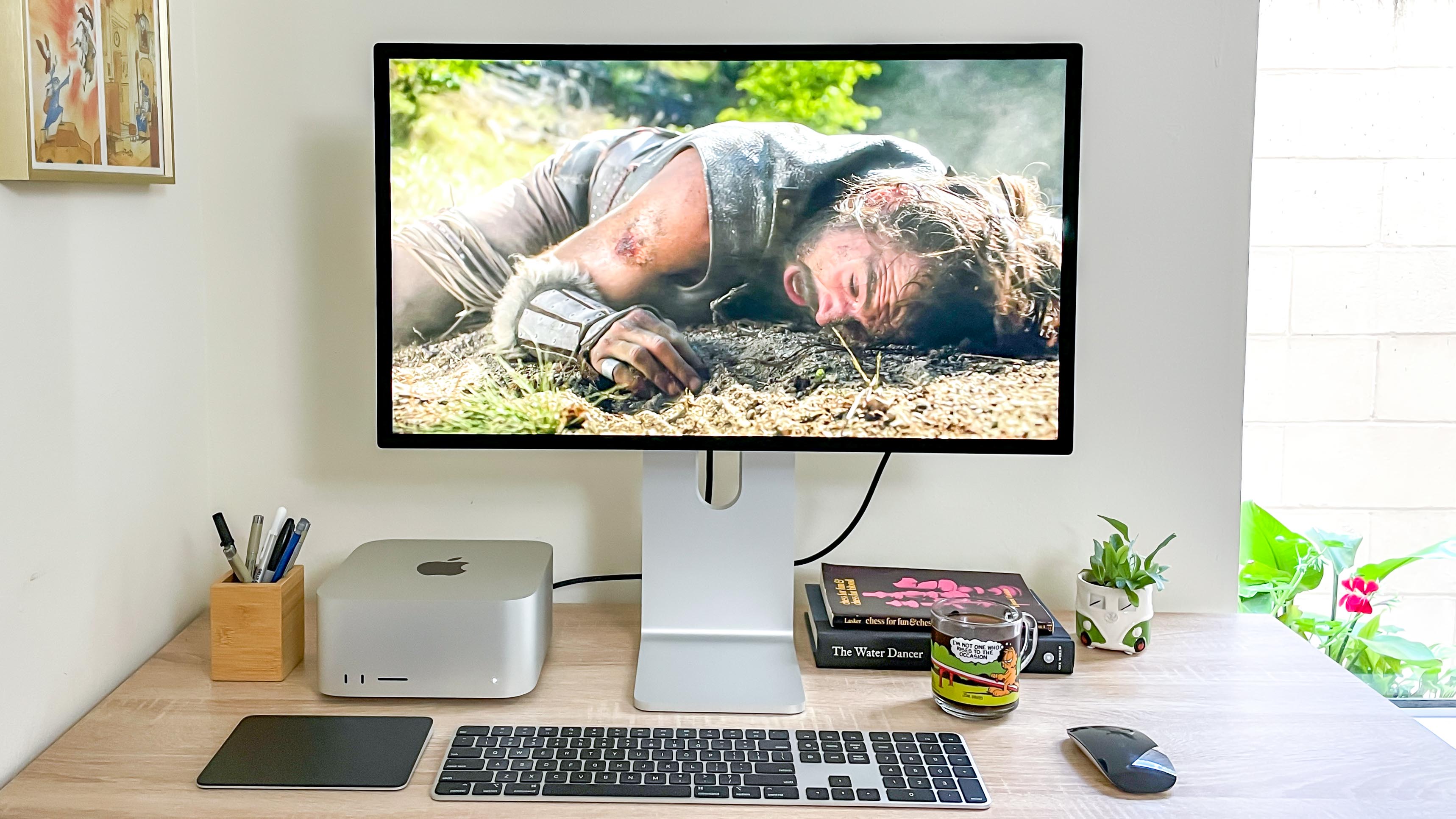
The Pro Display XDR looks quite a bit like the Studio Display, except it's bigger, older and more expensive. Like the Studio Display the Pro Display XDR is a big slab of metal and screen, but it's dominated by a beautiful 32-inch 6K display that you can also get with a nano-texture glass coating for an astounding additional $1,000. So if you need the biggest, most beautiful Apple display possible, you want the Pro Display XDR.
Unfortunately, it's going to cost you a ridiculous amount of money. The Pro Display XDR doesn't come with a stand despite costing $5,000 (or $6,000 with nano-texture glass), and if you want one you'll need to pay Apple an additional $999 for the matching Pro Stand. However, it's a well-designed stand that uses magnets to make connecting it to the Pro Display XDR a cinch, and its unique construction allows you to both adjust the height and tilt of the display and rotate it.
So if you prefer your displays in portrait mode vs landscape, the Pro Display XDR can accommodate your needs better than the new Studio Display.
Apple Studio Display vs Pro Display XDR: Screen
The 27-inch 5K (5,120 x 2,880 pixels) screen on the Studio Display looks beautiful in person, displaying over 14.7 million pixels at a density of 218 ppi (pixels per inch).
The Display also supports the P3 wide color gamut and comes pre-configured with a range of reference modes that creatives can switch between as projects demand. These modes adjust settings like white point, gamma and color space to accommodate creatives working on different types of projects. However, the Studio Display lacks support for the HDR Video reference mode, which makes sense since the Display can't display HDR (high dynamic range) content.
Sadly, the Studio Display's refresh rate tops out at 60Hz. That's fine for most tasks, but it can't match the 120Hz ProMotion adaptive refresh rate available on other Apple products like the 2021 MacBook Pros and iPad Pros.
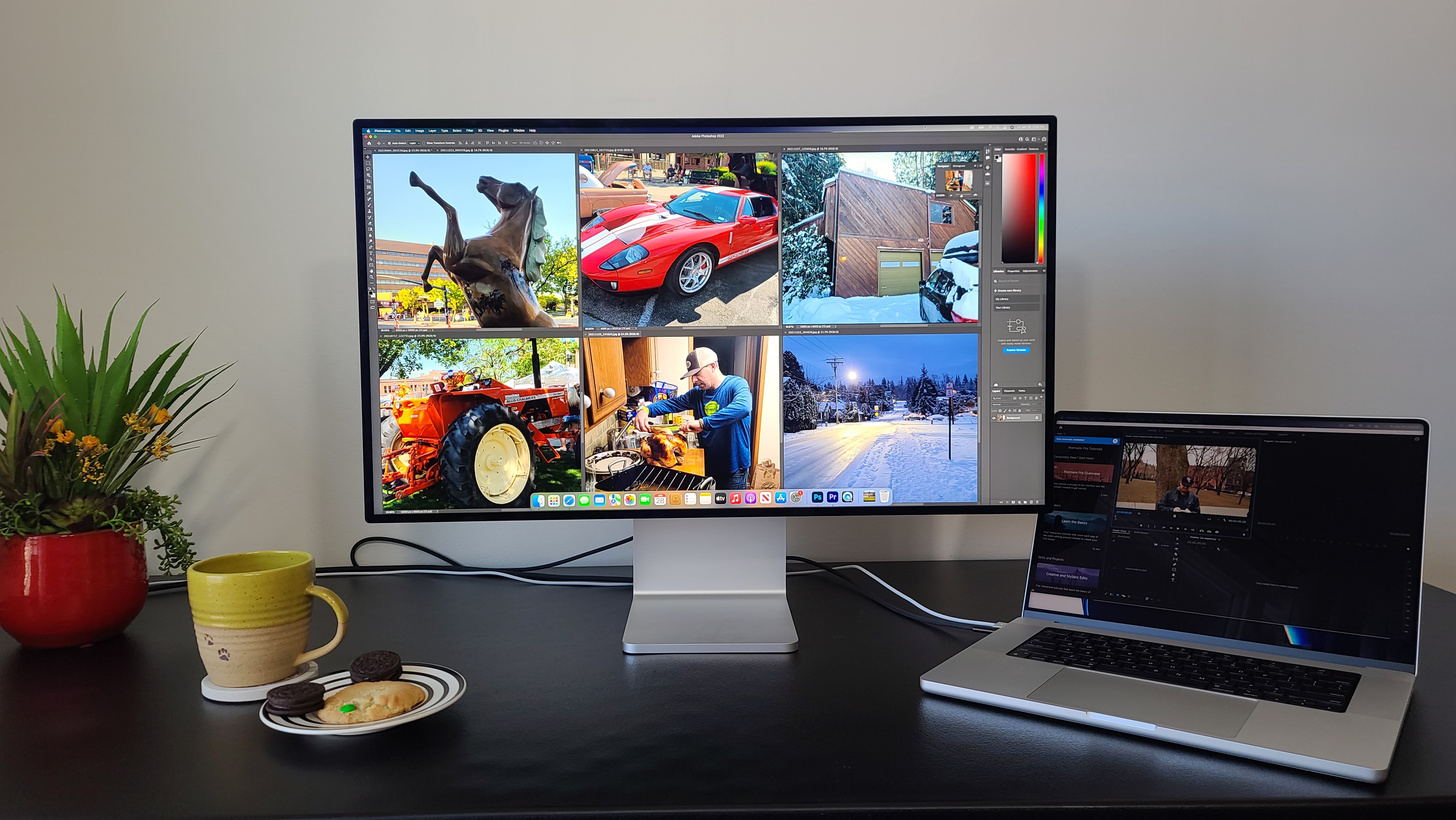
The older Pro Display XDR's 32-inch 6K (6,016 x 3,384 pixels, 20.4 million pixels at 218 PPI) screen also tops out at 60Hz, though that's a bit more forgivable since it launched in 2019, before Apple started going hard on ProMotion displays. Despite that age, the Pro Display XDR has the superior screen here, which makes sense given it costs nearly 3x as much as the Studio Display.
| Row 0 - Cell 0 | Studio Display | Pro DIsplay XDR |
| Average brightness | 518.4 nits | 466.8 nits |
| Max brightness | 563 nits (center) | 467 nits (center) |
| sRGB color gamut | 114.1% | 106.7% |
| DCI-P3 color gamut | 80.8% | 75.6% |
| Delta-E | 0,21 | 0.2 |
Specifically, the Pro Display XDR can display HDR (high dynamic range) content, and it supports a wider range of reference modes (including custom modes) than the Studio Display. Like the Studio Display it also supports the P3 wide color gamut, and Apple claims it can get much brighter — up to 1,000 nits peak brightness (or up to 1,600 nits on HDR content), vs the 600 nits peak brightness the Studio Display can achieve, according to Apple. However, in our testing we found that when viewing non-HDR content, the Studio Display can actually achieve higher brightness levels than the Pro DIsplay XDR (563 nits vs 467 nits).
Still, the Pro Display XDR can blow past the Studio Display when viewing HDR content. This is where the Apple's ultra-expensive Pro display really holds the biggest advantage over the Studio Display, as its screen is bigger, better and more capable in nearly every regard. Again, not surprising given the difference in cost.
Apple Studio Display vs Pro Display XDR: Speakers
The six-speaker sound system built into the Display is remarkably good for a monitor, delivering crisp, clear vocals and some surprisingly heavy bass. It supports Spatial Audio via Dolby Atmos, which means supported music and videos can sound like they're happening around you instead of just on the screen. Apple's spatial audio tech is already available on a range of devices, and in our hands-on testing we found it to be a cool feature. While it doesn't actually make music sound as though it's surrounding you, it does make the sound feel as though it's being "pushed" out of the monitor at you in a way that make it feel more immersive.
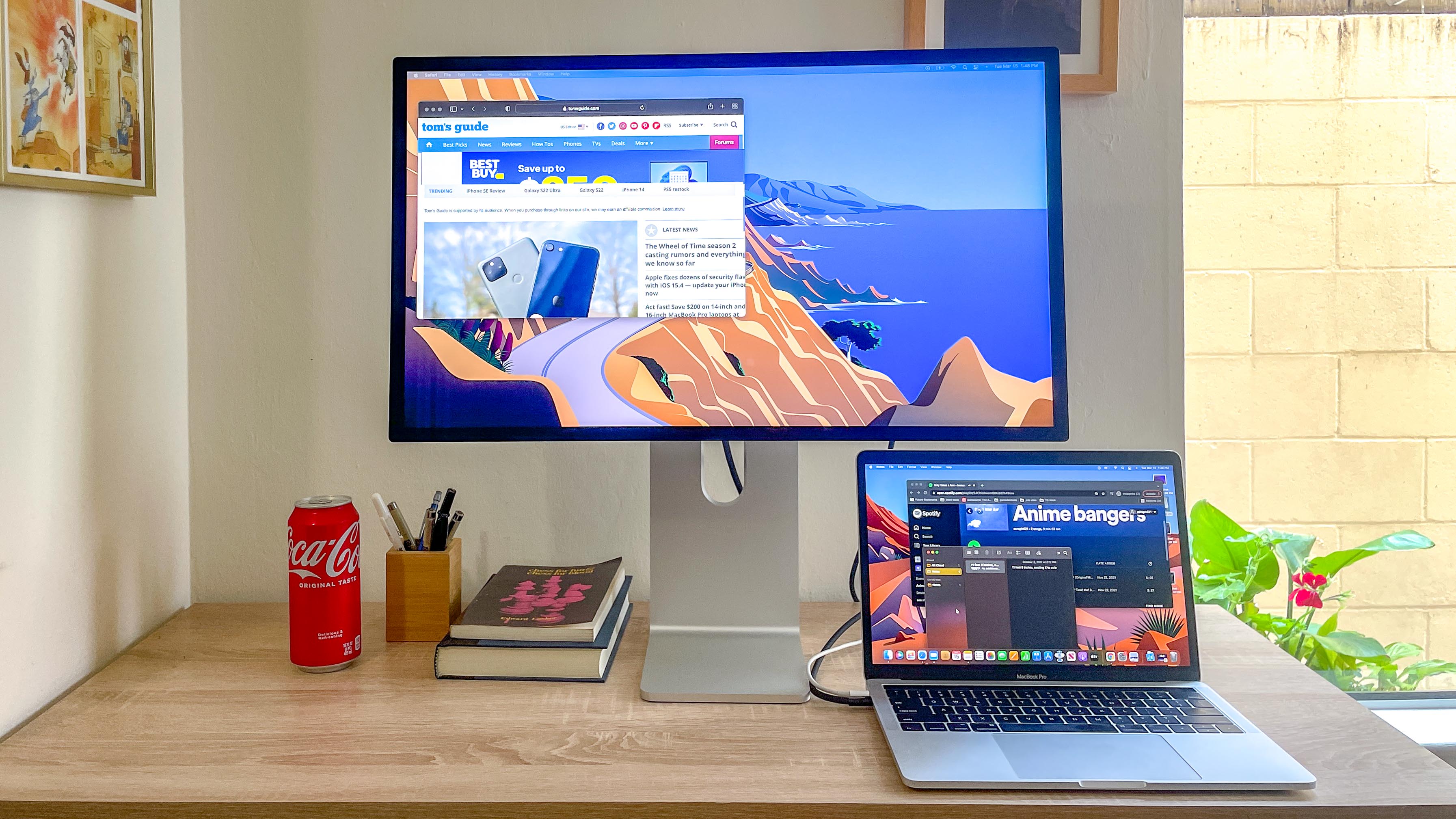
The older Pro Display XDR can't really compare here, as it doesn't have any speakers to, er, speak of. If you want to listen to music while working on the XDR, you'll have to listen on your MacBook's integrated speakers or invest in a set of the best computer speakers for your needs.
Apple Studio Display vs Pro Display XDR: Ports
Apple shipped the Studio Display with three USB-C ports and one Thunderbolt 3 port that can charge whatever you plug into it, so you can hook a MacBook up to drive the display and charge it while you work.
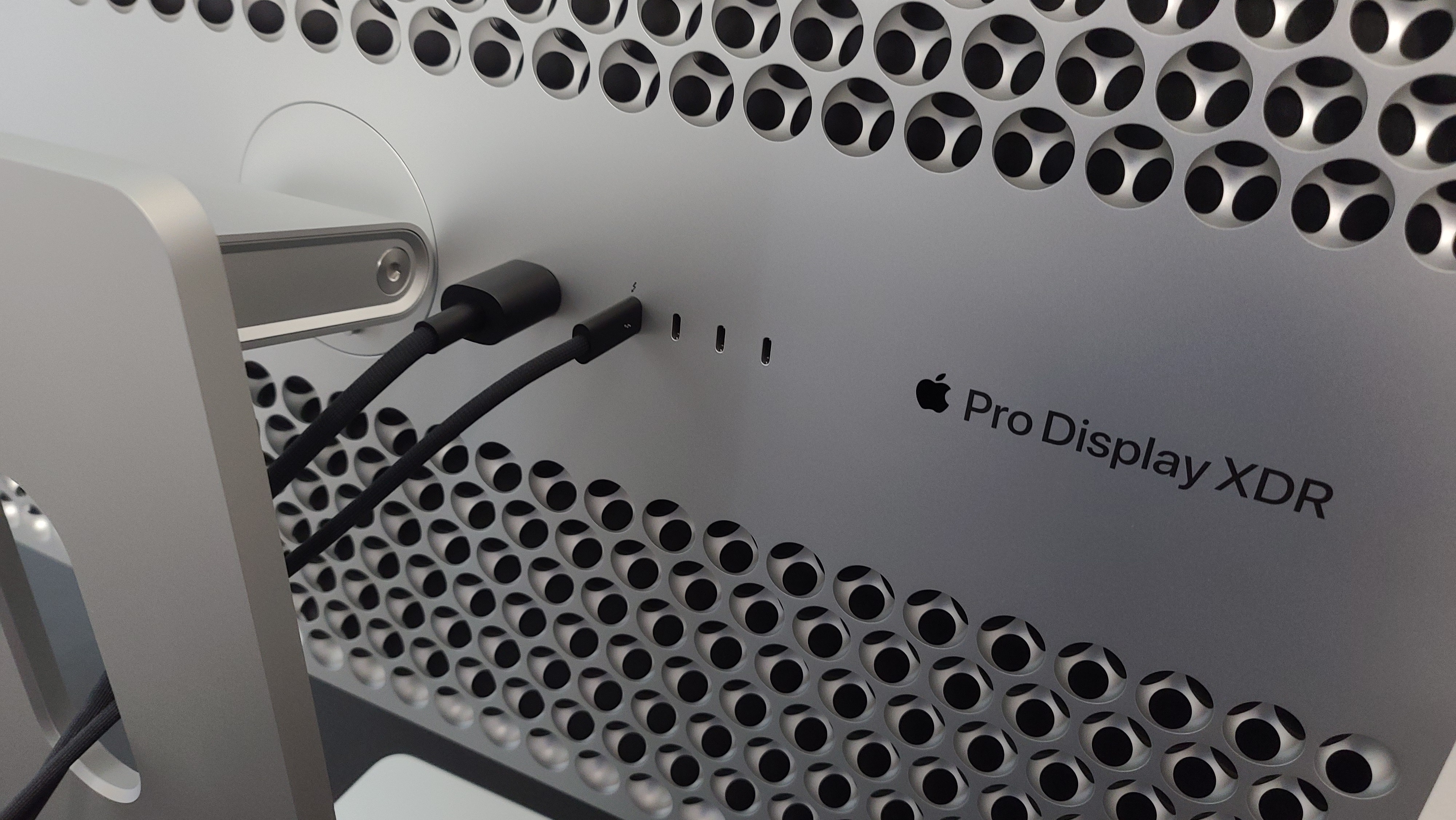
The Pro Display XDR offers the same port array, though it has a detachable power cable, whereas the Studio Display's is permanently grafted to the monitor.
Apple Studio Display vs Pro Display XDR: Webcam
The 12MP ultrawide camera built into the top bezel of the Studio Display is effectively the same camera as what's on the iPad Air (2022), and in our hands-on experience it captures images and video of comparable quality. In our review we lauded the quality of images/video captured by the camera, though we're continuing to test it as we noticed some discrepancies in image quality between different videoconferencing apps.
A firmware update from Apple looks to address some user complaints about webcam image quality that some users brought up with the Studio Display. We've tested the beta of that firmware and saw some improvements to Apple Studio Display image quality, though we're not sure it will be noticeable to most people.
The Studio Display's built-in webcam also supports Apple's Center Stage feature, which automatically crops and zooms the shot to keep you in frame if you move around during a video call. It's a neat feature that works well, though it seems a lot less useful on a deskbound monitor than it is on iPads, since tablets are much easier to move around with and set up to capture specific shots.

Here again the Pro Display XDR just can't compete, as it doesn't have a built-in webcam. If you want to do some video chatting, you're limited to whatever webcam is connected to your Mac.
Apple Studio Display vs Pro Display XDR: Verdict
When Apple first unveiled the new Studio Display with for $1,599 it seemed like it might be a cheaper spin on the Pro Display XDR. Now that we've had some time to review it ourselves, it's clear that the Studio Display can't match the professional strengths of its older sibling.
The Pro Display XDR is bigger, brighter and better optimized for professional content creators thanks to its HDR support, higher pixel count and expanded array of reference modes. Of course, it has a commensurately pro-grade price tag: With a starting price of $4,999 (and that doesn't even get you a stand) nobody but businesses and well-funded creators should invest in a Pro Display XDR.
For every other Mac user in need of an external display, the Studio Display is a great choice. What it lacks in pro-grade features it makes up for with more broadly appealing features like a 12MP webcam and a quality integrated speaker system. Just know that many of its features (like Center Stage) shine only when you connect it to a supported MacBook or iPad running at least macOS Monterey 12.3 or iPadOS 15.4; plug it into a Windows machine and it becomes just a 5K secondary display with integrated camera and speakers.
Sign up to get the BEST of Tom's Guide direct to your inbox.
Get instant access to breaking news, the hottest reviews, great deals and helpful tips.

Alex Wawro is a lifelong tech and games enthusiast with more than a decade of experience covering both for outlets like Game Developer, Black Hat, and PC World magazine. A lifelong PC builder, he currently serves as a senior editor at Tom's Guide covering all things computing, from laptops and desktops to keyboards and mice.
-
Elterrible Alienware QD OLED would be a better option in my opinion, or an ASUS ProArt 10 Bit display.Reply
